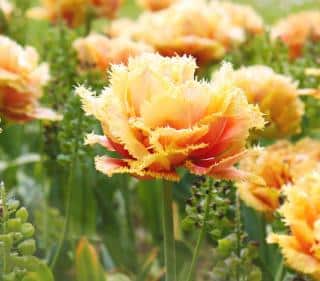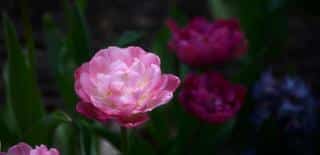

The peony tulip earned its name thanks to its lush, thick blooms, similar to those of the original peony. Colors and shapes vary greatly from one variety to the next.
Peony tulip key facts
Botanical name – Tulipa
Common name – peony tulip, late double tulip, peony-flowered tulip
Family – Liliaceae
Type – bulb flower
Height – 10 to 24 inches (25 to 60cm)
Landscaping uses – garden box, flower bed, rock garden
Planting distance – 6 inches (15 cm)
Exposure – full sun to partial shade
Soil – loamy clay, well-draining, cool
Planting – fall
Flowering April to May
Particularly beloved of gardeners in recent years, the peony tulip family stand out thanks to their large double flowers which gives them their other name: late double tulip. Sometimes a single stem will even produce more than one flower!
There are a great many peony tulip varieties, but the most famous are without a doubt:
 ‘Carnaval de Nice’ with a beautiful white and red flower head;
‘Carnaval de Nice’ with a beautiful white and red flower head;
Though peony tulip is most often grown to decorate flower beds, it’s also a prime choice for bouquets. Indeed, each bloom lasts for several days, even after the stem has been cut. To savor the peony tulip for an even longer time in your bouquets, pick it while the flower bud is just barely opened.
As is common for most types of tulip, the peony tulip loves growing in light and well-draining soil. Best is to set your flowers in full sun locations, rather than shady spots. This will ensure they develop well. Peony tulip has very long stems. Though they are relatively sturdy and strong, it’s still best to make sure they’re properly sheltered from wind.
Apart from winter, regular watering will help it grow well, preferably at night after the sunset. Over the fall and during very dry winters, water your tulip bulbs occasionally to promote root growth and, subsequently, future blooming.
Plant your double tulips in flower beds, in rocky terrain, or even in deep containers.
 Ideally, fall is the best time to plant your peony tulip bulbs: anytime between October and December.
Ideally, fall is the best time to plant your peony tulip bulbs: anytime between October and December.Late double tulips easily coexist with early spring perennials, as they do with other tulips. Indeed, peony tulips scattered about here and there will help grow flower beds full of rich colors, appealing contrast, and spectacular shapes. Paired with botanical tulips and the stunning parrot tulip, it’ll work wonders!